Comparison of COSMIC and COSMIC-2 Radio Occultation Refractivity and Bending Angle Uncertainties in August 2006 and 2021
Abstract
:1. Introduction
2. Summary of Three-Cornered Hat Method and the Data Sets
2.1. Three-Cornered Hat Method of Estimating Error Statistics
2.2. Data Sets
2.2.1. COSMIC and COSMIC-2 Radio Occultation Bending Angles and Refractivities
2.2.2. ERA5 (ECMWF Reanalysis Fifth Generation)
2.2.3. MERRA-2 Reanalysis
3. Sources of Radio Occultation Errors
4. Atmospheric Structure during August 2006 and 2021
5. Comparison of COSMIC and COSMIC-2
5.1. Penetration Depths of COSMIC and COSMIC-2
5.2. Differences between C2 GPS and GLONASS Uncertainties
5.3. Uncertainty Estimates of COSMIC and COSMIC-2
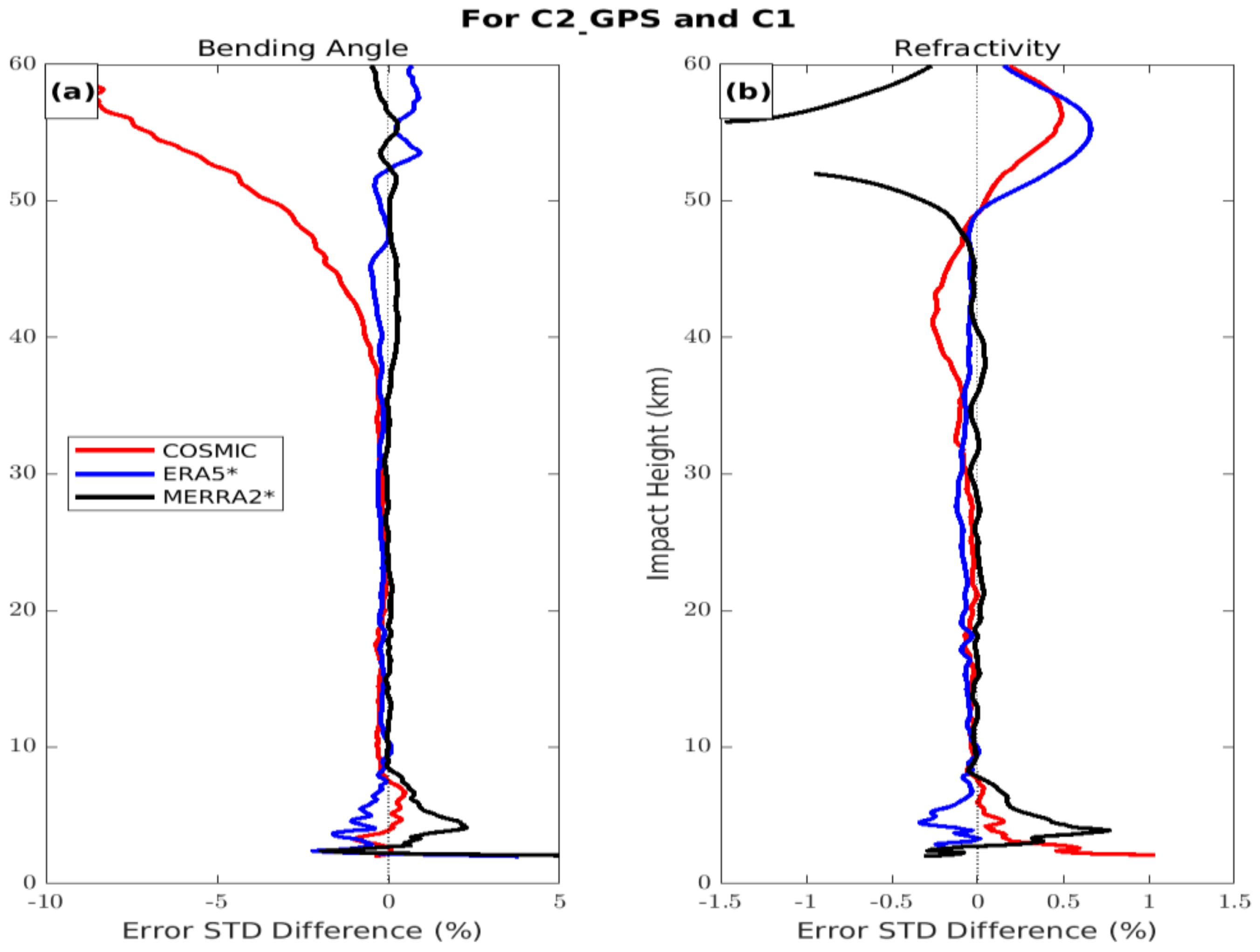
5.4. Latitudinal Variations of C2 Uncertainty Estimates and Differences from C1
6. Summary and Conclusions
Author Contributions
Funding
Institutional Review Board Statement
Informed Consent Statement
Data Availability Statement
Acknowledgments
Conflicts of Interest
References
- Ware, R.; Exner, M.; Feng, D.; Gorbunov, M.; Hardy, K.; Herman, B.; Kuo, Y.; Meehan, T.; Melbourne, W.; Rocken, C.; et al. GPS sounding of the atmosphere from Low Earth Orbit: Preliminary results. Bull. Am. Meteorol. Soc. 1996, 77, 19–40. [Google Scholar] [CrossRef] [Green Version]
- Healy, S.B.; Thépaut, J.N. Forecast impact experiment with GPS radio occultation measurements. Q. J. R. Meteorol. Soc. 2006, 132, 605–623. [Google Scholar] [CrossRef]
- Healy, S.B.; Eyre, J.R.; Hamrun, M.; Thépaut, J.N. Assimilating GPS radio occultation measurements with two-dimensional bending angle observation operators. Q. J. R. Meteorol. Soc. 2007, 133, 1213–1227. [Google Scholar] [CrossRef]
- Healy, S.B. Forecast impact experiment with a constellation of GPS radio occultation receivers. Atmos. Sci. Lett. 2008, 9, 111–118. [Google Scholar] [CrossRef]
- Aparicio, J.M.; Deblonde, G. Impact of the assimilation of CHAMP refractivity profiles on Environment Canada global forecasts. Mon. Weather Rev. 2008, 136, 257–275. [Google Scholar] [CrossRef]
- Poli, P.; Moll, P.; Puech, D.; Rabier, F.; Healy, S.B. Quality control, error analysis, and impact assessment of FORMOSAT-3/COSMIC in numerical weather prediction. Terr. Atmos. Ocean. Sci. 2009, 20, 101–113. [Google Scholar] [CrossRef] [Green Version]
- Poli, P.; Healy, S.B.; Dee, D.P. Assimilation of global positioning system radio occultation data in the ECMWF ERAi reanalysis. Q. J. R. Meteorol. Soc. 2010, 136, 1972–1990. [Google Scholar] [CrossRef]
- Cardinali, C. Monitoring the observation impact on the short-range forecast. Q. J. R. Meteorol. Soc. 2009, 135, 239–250. [Google Scholar] [CrossRef]
- Rennie, M.P. The impact of GPS radio occultation assimilation at the. Meteorological Office. Q. J. R. Meteorol. Soc. 2010, 136, 116–131. [Google Scholar] [CrossRef]
- Cardinali, C.; Healy, S. Impact of GPS radio occultation measurements in the ECMWF system using adjoint based diagnostics. Q. J. R. Meteorol. Soc. 2014, 140, 2315–2320. [Google Scholar] [CrossRef]
- Bonavita, M. On some aspects of the impact of GPSRO observations in global numerical weather prediction. Q. J. R. Meteorol. Soc. 2014, 140, 2546–2562. [Google Scholar] [CrossRef] [Green Version]
- Bauer, P.; Radnóti, G.; Healy, S.; Cardinali, C. GNSS Radio Occultation Constellation Observing System Experiments. Mon. Weather Rev. 2014, 142, 555–572. [Google Scholar] [CrossRef]
- Chen, Y.-C.; Hsieh, M.-E.; Hsiao, L.-F.; Kuo, Y.-H.; Yang, M.-J.; Huang, C.-Y.; Lee, C.-S. Systematic evaluation of the impacts of GPSRO data on the prediction of typhoons over the northwestern Pacific in 2008–2010. Atmos. Meas. Tech. 2015, 8, 2531–2542. [Google Scholar] [CrossRef] [Green Version]
- Ruston, B.; Healy, S. Forecast Impact of FORMOSAT-7/COSMIC-2 GNSS Radio Occultation Measurements. Atmos. Sci. Lett. 2020, 22, e1019. [Google Scholar] [CrossRef]
- Lackner, B.C.; Steiner, A.K.; Kirchengast, G.; Hegerl, G.C. Atmospheric climate change detection by radio occultation data using a fingerprinting method. J. Clim. 2011, 24, 5275–5291. [Google Scholar] [CrossRef] [Green Version]
- Steiner, A.K.; Lackner, B.C.; Pirscher, B.; Borsche, M.; Foelsche, U. Atmospheric temperature change detection with GPS radio occultation 1995 to 2008. Geophys. Res. Lett. 2009, 36, L18702. [Google Scholar] [CrossRef] [Green Version]
- Steiner, A.K.; Lackner, B.C.; Ladstädter, F.; Scherllin-Pirscher, B.; Foelsche, U.; Kirchengast, G. GPS radio occultation for climate monitoring and change detection. Radio Sci. 2011, 46, RS0D24. [Google Scholar] [CrossRef] [Green Version]
- Steiner, A.K.; Ladstädter, F.; Ao, C.O.; Gleisner, H.; Ho, S.P.; Hunt, D.; Schmidt, T.; Foelsche, U.; Kirchengast, G.; Kuo, Y.H.; et al. Consistency and structural uncertainty of multi-mission GPS radio occultation records. Atmos. Meas. Tech. 2020, 13, 2547–2575. [Google Scholar] [CrossRef]
- Ho, S.-P.; Anthes, R.A.; Ao, C.O.; Healy, S.; Horanyi, A.; Hunt, D.; Mannucci, A.J.; Pedatella, N.; Randel, W.J.; Simmons, A. The COSMIC/FORMOSAT-3 radio occultation mission after 12 years: Accomplishments, remaining challenges, and potential impacts of COSMIC-2. Bull. Am. Meteorol. Soc. 2020, 101, E1107–E1136. [Google Scholar] [CrossRef] [Green Version]
- Schreiner, W.S.; Weiss, J.P.; Anthes, R.A.; Braun, J.; Chu, V.; Fong, J.; Hunt, D.; Kuo, Y.-H.; Meehan, T.; Serafino, W.; et al. COSMIC-2 radio occultation-first results. Geophys. Res. Lett. 2020, 47, e2019GL086841. [Google Scholar] [CrossRef]
- Ho, S.P.; Zhou, X.; Shao, X.; Zhang, B.; Adhikari, L.; Kireev, S.; He, Y.; Yoe, J.G.; Xia-Serafino, W.; Lynch, E. Initial assessment of the COSMIC-2/FORMOSAT-7 neutral atmosphere data quality in NESDIS/STAR using in situ and satellite data. Remote Sens. 2020, 12, 4099. [Google Scholar] [CrossRef]
- Kursinski, E.R.; Hajj, G.A.; Hardy, K.R.; Schofield, J.T.; Linfield, R. Observing Earth’s atmosphere with radio occultation measurements. J. Geophys. Res. 1997, 102, 23429–23465. [Google Scholar] [CrossRef]
- Lohmann, M. Analysis of Global Positioning System (GPS) radio occultation measurement errors based on Satellite de Aplicaciones Cientificas-C (SAC-C) GPS radio occultation data recorded in open-loop and phase-locked-loop mode. J. Geophys. Res. 2007, 112, D09115. [Google Scholar] [CrossRef] [Green Version]
- Syndergaard, S.; Kuo, Y.-H.; Lohmann, M.S. Observation operators for the assimilation of occultation data into atmospheric models: A review. In Atmosphere and Climate-Studies by Occultation Methods; Foelsche, U., Kirchengast, G., Steiner, A., Eds.; Springer: Berlin/Heidelberg, Germany, 2006; pp. 205–224. [Google Scholar] [CrossRef]
- Wee, T.-K.; Kuo, Y.-H. A perspective on the fundamental quality of GPS radio occultation data. Atmos. Meas. Tech. 2015, 8, 4281–4294. [Google Scholar] [CrossRef] [Green Version]
- Desroziers, G.; Berre, L.; Chapnik, B.; Poli, P. Diagnosis of observation, background and analysis-error statistics in observation space. Q. J. R. Meteorol. Soc. 2005, 131, 3385–3396. [Google Scholar] [CrossRef]
- Fletcher, S.J. Data Assimilation for the Geosciences; Elsevier: New York, NY, USA, 2017; p. 941. ISBN 978-0-12-80444-5. [Google Scholar]
- Kuo, Y.-H.; Wee, T.-K.; Sokolovskiy, S.; Rocken, C.; Schreiner, W.; Hunt, D.; Anthes, R.A. Inversion and error estimation of GPS radio occultation data. J. Meteorol. Soc. Jpn. 2004, 82, 507–531. [Google Scholar] [CrossRef] [Green Version]
- Kuo, Y.-H.; Schreiner, W.S.; Wang, J.; Rossiter, D.L.; Zhang, Y. Comparison of GPS radio occultation soundings with radiosondes. Geophys. Res. Lett. 2005, 32, L05817. [Google Scholar] [CrossRef] [Green Version]
- He, W.; Ho, S.; Chen, H.; Zhou, X.; Hunt, D.; Kuo, Y. Assessment of radiosonde temperature measurements in the upper troposphere and lower stratosphere using COSMIC radio occultation data. Geophys. Res. Lett. 2009, 36, L17807. [Google Scholar] [CrossRef] [Green Version]
- Ho, S.-P.; Zhou, X.; Kuo, Y.; Hunt, D.; Wang, J. Global Evaluation of Radiosonde Water Vapor Systematic Biases using GPS Radio Occultation from COSMIC and ECMWF Analysis. Remote Sens. 2010, 2, 1320–1330. [Google Scholar] [CrossRef] [Green Version]
- Sun, B.; Reale, A.; Seidel, D.J.; Hunt, D.C. Comparing radiosonde and COSMIC atmospheric profile data to quantify differences among radiosonde types and the effects of imperfect collocation on comparison statistics. J. Geophys. Res. 2010, 115, D23104. [Google Scholar] [CrossRef] [Green Version]
- Ladstädter, F.; Steiner, A.K.; Schwärz, M.; Kirchengast, G. Climate intercomparison of GPS radio occultation, RS90/92 radiosondes and GRUAN from 2002 to 2013. Atmos. Meas. Tech. 2015, 8, 1819–1834. [Google Scholar] [CrossRef] [Green Version]
- Ho, S.-P.; Kuo, Y.-H.; Zeng, Z.; Peterson, T. A comparison of lower stratosphere temperature from microwave measurements with CHAMP GPS RO data. Geophys. Res. Lett. 2007, 34, L15701. [Google Scholar] [CrossRef] [Green Version]
- Ho, S.-P.; Goldberg, M.; Kuo, Y.-H.; Zou, C.-Z.; Schreiner, W. Calibration of temperature in the lower stratosphere from microwave measurements using COSMIC radio occultation data: Preliminary results. Terr. Atmos. Ocean. Sci. 2009, 20, 87–100. [Google Scholar] [CrossRef] [Green Version]
- Feltz, M.L.; Knuteson, R.; Ackerman, S.; Revercomb, H. Application of GPS RO to the assessment of temperature profile retrievals from microwave and infrared sounders. Atmos. Meas. Tech. 2014, 7, 3751–3762. [Google Scholar] [CrossRef] [Green Version]
- Vergados, P.; Mannucci, A.J.; Ao, C.O. Assessing the performance of GPS radio occultation measurements in retrieving tropospheric humidity in cloudiness: A comparison study with radiosondes, ERA-Interim, and AIRS data sets. J. Geophys. Res. Atmos. 2014, 119, 7718–7731. [Google Scholar] [CrossRef]
- Rieckh, T.; Anthes, R.; Randel, W.; Ho, S.-P.; Foelsche, U. Evaluating tropospheric humidity from GPS radio occultation, radiosonde, and AIRS from high-resolution time series. Atmos. Meas. Tech. 2017, 11, 3091–3109. [Google Scholar] [CrossRef] [Green Version]
- Anthes, R.A.; Rieckh, T. Estimating observation and model error variances using multiple data sets. Atmos. Meas. Tech. 2018, 11, 4239–4260. [Google Scholar] [CrossRef] [Green Version]
- Sjoberg, J.P.; Anthes, R.A.; Rieckh, T. The three-cornered hat method for estimating error variances of three or more data sets-Part I: Overview and Evaluation. J. Atmos. Ocean. Technol. 2021, 38, 555–572. [Google Scholar] [CrossRef]
- Rieckh, T.; Sjoberg, J.; Anthes, R.A. The three-cornered hat method for estimating error variances of three or more data sets-Part II: Evaluating radio occultation and radiosonde observations, global model forecasts, and reanalyses. J. Atmos. Ocean. Technol. 2021, 38, 1777–1796. [Google Scholar] [CrossRef]
- Semane, N.; Anthes, R.; Sjoberg, J.; Ruston, B.; Healy, S. Comparison of Desroziers and Three-Cornered Hat Methods for Estimating COSMIC-2 Bending Angle Uncertainties. J. Atmos. Ocean. Tech. 2022, 39. (in press). [Google Scholar] [CrossRef]
- Hollingsworth, A.; Lönnberg, P. The statistical structure of short-range forecast errors as determined from radiosonde data. Part I: The wind field. Tellus A Dyn. Meteorol. Oceanogr. 1986, 38, 111–136. [Google Scholar] [CrossRef] [Green Version]
- Todling, R.; Semane, N.; Anthes, R.; Healy, S. The relationship between Desroziers and Three-Cornered Hat methods. Q. J. R. Meteorol. Soc. 2022, 142, 65–78. [Google Scholar]
- Sokolovskiy, S.; Schreiner, W.; Weiss, J.; Zeng, Z.; Hunt, D.; Braun, J. Initial Assessment of COSMIC-2 Data in the Lower Troposphere (LT) Joint 6th ROM SAF Data User Workshop and 7th IROWG Workshop; Konventum: Elsinore, Denmark, 2019; Available online: https://www.romsaf.org/romsaf-irowg-2019/en/open/1570202428.cf195c6aa62789cfb81f06d529ecdf0f.pdf/Sokolovskiy__IROWG-UCAR-C2-LT_Final.pdf (accessed on 4 March 2022).
- Sokolovskiy, S. Standard RO Inversions in the Neutral Atmosphere 2013–2020 (Processing Steps and Explanation of Data). 2021. Available online: https://www.cosmic.ucar.edu/sites/default/files/2021-09/cdaac_ro_retrieval_description_v1.pdf (accessed on 27 January 2022).
- Hersbach, H.; Bell, B.; Berrisford, P.; Hirahara, S.; Horányi, A.; Muñoz-Sabater, J.; Nicolas, J.; Peubey, C.; Radu, R.; Schepers, D. The ERA5 global reanalysis. Q. J. R. Meteorol. Soc. 2020, 146, 1999–2049. [Google Scholar] [CrossRef]
- Gelaro, R.; McCarty, W.; Suárez, M.J.; Todling, R.; Molod, A.; Takacs, L.; Randles, C.A.; Darmenov, A.; Bosilovich, M.G.; Reichle, R.; et al. The Modern-Era Retrospective Analysis for Research and Applications, version 2 (MERRA-2). J. Clim. 2017, 30, 5419–5454. [Google Scholar] [CrossRef]
- Melbourne, W.G.; Davis, E.S.; Duncan, C.B.; Hajj, G.A.; Hardy, K.R.; Kursinski, E.R.; Meehan, T.K.; Young, L.E.; Yunck, T.P. The Application of Spaceborne GPS to Atmospheric Limb Sounding and Global Change Monitoring; JPL Publication: La Cañada Flintridge, CA, USA, 1994; pp. 18–94, 147. Available online: https://ntrs.nasa.gov/citations/19960008694 (accessed on 4 March 2022).
- Ahmad, B.; Tyler, G.L. Systematic errors in atmospheric profiles obtained from Abelian inversion of radio occultation phase data. Effects of large-scale horizontal gradients. J. Geophys. Res. 1999, 104, 3971–3992. [Google Scholar]
- Syndergaard, S.; Kursinski, E.R.; Herman, B.; Lane, E.M.; Flittner, D.E. A Refractive Index Mapping Operator for Assimilation of Occultation Data. Mon. Weather Rev. 2005, 133, 2650–2668. [Google Scholar] [CrossRef]
- Withers, P. Prediction of uncertainties in atmospheric properties measured by radio occultation experiments. Adv. Space Res. 2010, 46, 58–73. [Google Scholar] [CrossRef]
- Lonitz, K.; Marquardt, C.; Bowler, N.; Healy, S. Impact Assessment of Commercial GNSS-RO Data; ECMWF Technical Note, Contract Report ESA Contract No. 4000131086120/NL/FF/a; European Centre for Medium Range Weather Forecasts: Reading, UK, 2021. [Google Scholar] [CrossRef]
- Lohmann, M.S. Application of dynamical error estimation for statistical optimization of radio occultation bending angles. Radio Sci. 2005, 40, RS3011. [Google Scholar] [CrossRef] [Green Version]
- Mannucci, A.J.; Ao, C.O.; Pi, X.; Iijima, B.A. The impact of large scale ionospheric structure on radio occultation retrievals. Atmos. Meas. Tech. 2011, 4, 2837–2850. [Google Scholar] [CrossRef] [Green Version]
- Danzer, J.; Scherllin-Pirscher, B.; Foelsche, U. Systematic residual ionospheric errors in radio occultation data and a potential way to minimize them. Atmos. Meas. Tech. 2013, 6, 2169–2179. [Google Scholar] [CrossRef] [Green Version]
- Coleman, C.J.; Forte, B. On the residual ionospheric error in radio occultation measurements. Radio Sci. 2017, 52, 918–937. [Google Scholar] [CrossRef] [Green Version]
- Gobiet, A.; Kirchengast, G. Advancements of Global Navigation Satellite System radio occultation retrieval in the upper stratosphere for optimal climate monitoring utility. J. Geophys. Res. 2004, 109, D24110. [Google Scholar] [CrossRef] [Green Version]
- Hocke, K. Inversion of GPS meteorology data. Ann. Geophys. 1997, 15, 443–450. [Google Scholar] [CrossRef]
- Syndergaard, S. On the ionosphere calibration in GPS radio occultation measurements. Radio Sci. 2000, 35, 865–883. [Google Scholar] [CrossRef]
- Gurvich, A.S.; Sokolovskiy, S.V. Reconstruction of a pressure field by remote refractometry from space. Izv. Atmos. Ocean. Phys. 1985, 21, 7–13. [Google Scholar]
- Zou, X.; Vandenberghe, F.; Wang, B.; Gorbunov, M.E.; Kuo, Y.-H.; Sokolovskiy, S.; Chang, J.C.; Sela, J.G.; Anthes, R.A. A ray-tracing operator and its adjoint for use in GPS/MET refraction angle measurements. J. Geophys. Res. 1999, 104, 22301–22318. [Google Scholar] [CrossRef] [Green Version]
- Zou, X.; Liu, H.; Anthes, R.A. A statistical summary of errors in the calculation of radio-occultation bending angles caused by a 2D approximation of ray tracing and the assumption of spherical symmetry of the atmosphere. J. Atmos. Ocean. Tech. 2002, 19, 51–64. [Google Scholar] [CrossRef]
- Healy, S.B. Radio occultation bending angle and impact errors caused by horizontal refractive index gradients in the troposphere: A simulation study. J. Geophys. Res. 2001, 106, 11875–11889. [Google Scholar] [CrossRef]
- Foelsche, U.; Kirchengast, G. Sensitivity of GNSS occultation profiles to horizontal variability in the troposphere: A simulation study. In Occultations for Probing Atmosphere and Climate, 2004; OPAC-1; Springer: New York, NY, USA, 2004; pp. 127–136, 408. ISBN 3-540-22350-9. [Google Scholar]
- Sokolovskiy, S.; Kuo, Y.-H.; Wang, W. Assessing the Accuracy of a Linearized Observation Operator for Assimilation of Radio Occultation Data: Case Simulations with a High-Resolution Weather Model. Mon. Weather Rev. 2005, 133, 2200–2212. [Google Scholar] [CrossRef] [Green Version]
- Gorbunov, M.E.; Lauritsen, K.B. Error estimate of bending angles in the presence of strong horizontal gradients. In New Horizons in Occultation Research; Steiner, A., Pirscher, B., Foelsche, U., Kirchengast, H., Eds.; Springer: New York, NY, USA, 2009; pp. 17–26. [Google Scholar] [CrossRef]
- Wee, T.-K. A variational regularization of Abel transform for GPS radio occultation. Atmos. Meas. Tech. 2018, 11, 1947–1969. [Google Scholar] [CrossRef] [Green Version]
- Liu, H.; Zou, X. Comparison of GNSS Bending Angle Simulations from the 1D Abel Transform and 2D Raytracing Operators in the Tropical Lower Troposphere. J. Aeronaut. Astronaut. Aviat. 2018, 50, 405–414. [Google Scholar] [CrossRef]
- Schlatter, T.W. Variational assimilation of meteorological observations in the lower atmosphere: A tutorial on how it works. J. Atmos. Sol.-Terr. Phys. 2000, 62, 1057–1070. [Google Scholar] [CrossRef]
- Baldwin, M.P.; Gray, L.J.; Dunkerton, T.J.; Hamilton, K.; Haynes, P.H.; Randel, W.J.; Holton, J.R.; Alexander, M.J.; Hirota, I.; Horinouchi, T. The quasi-biennial oscillation. Rev. Geophys. 2001, 36, 179–229. [Google Scholar] [CrossRef]
- Healy, S. Estimates of GNSS radio occultation bending angle and refractivity error statistics. ROM SAF Rep. 2016, 26, 27. Available online: https://www.romsaf.org/general-documents/rsr/rsr_26.pdf (accessed on 4 March 2022).
- Rieckh, T.; Anthes, R.A. Evaluating two methods of estimating error variances using simulated data sets with known errors. Atmos. Meas. Tech. 2018, 11, 4309–4325. [Google Scholar] [CrossRef] [Green Version]

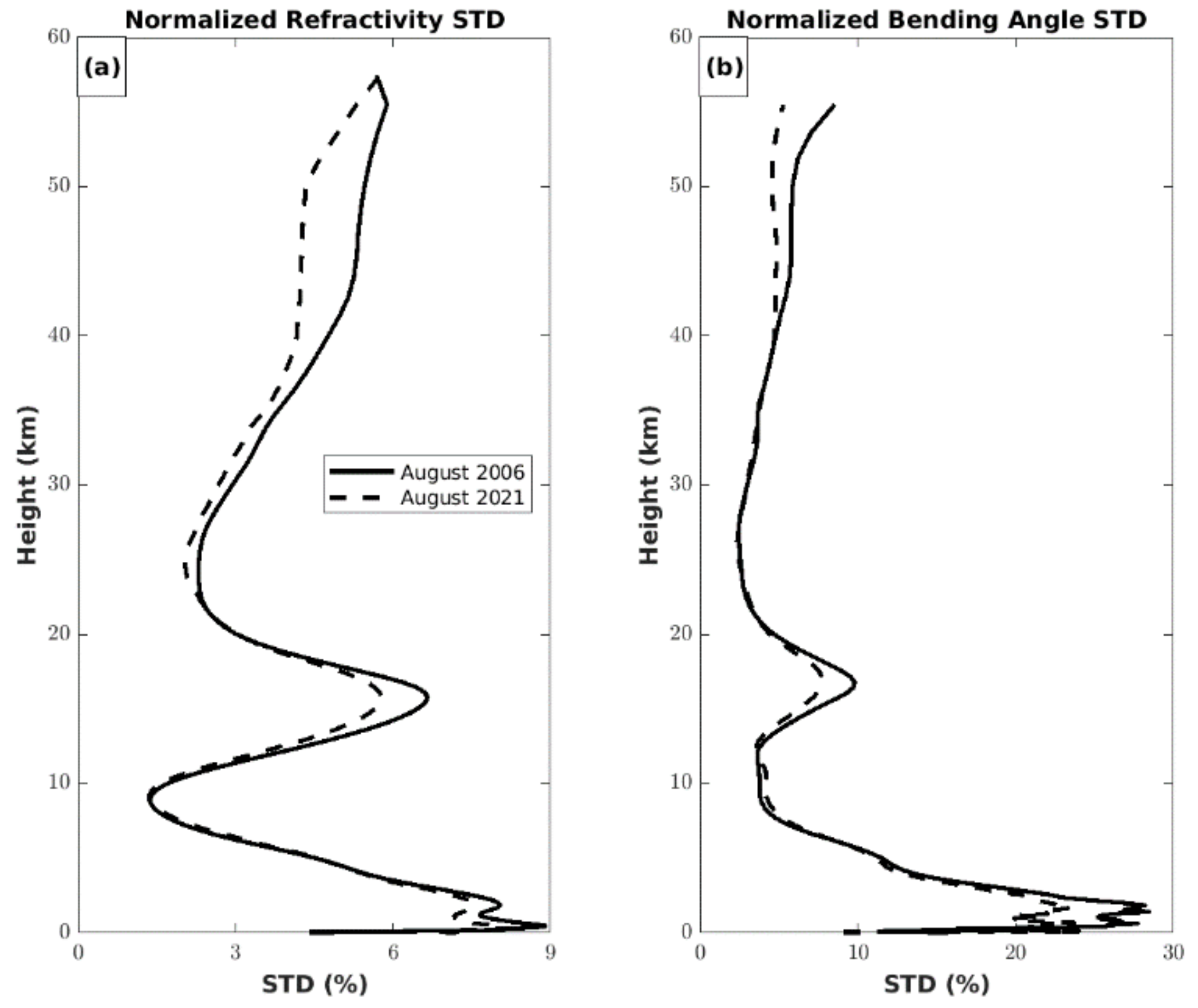

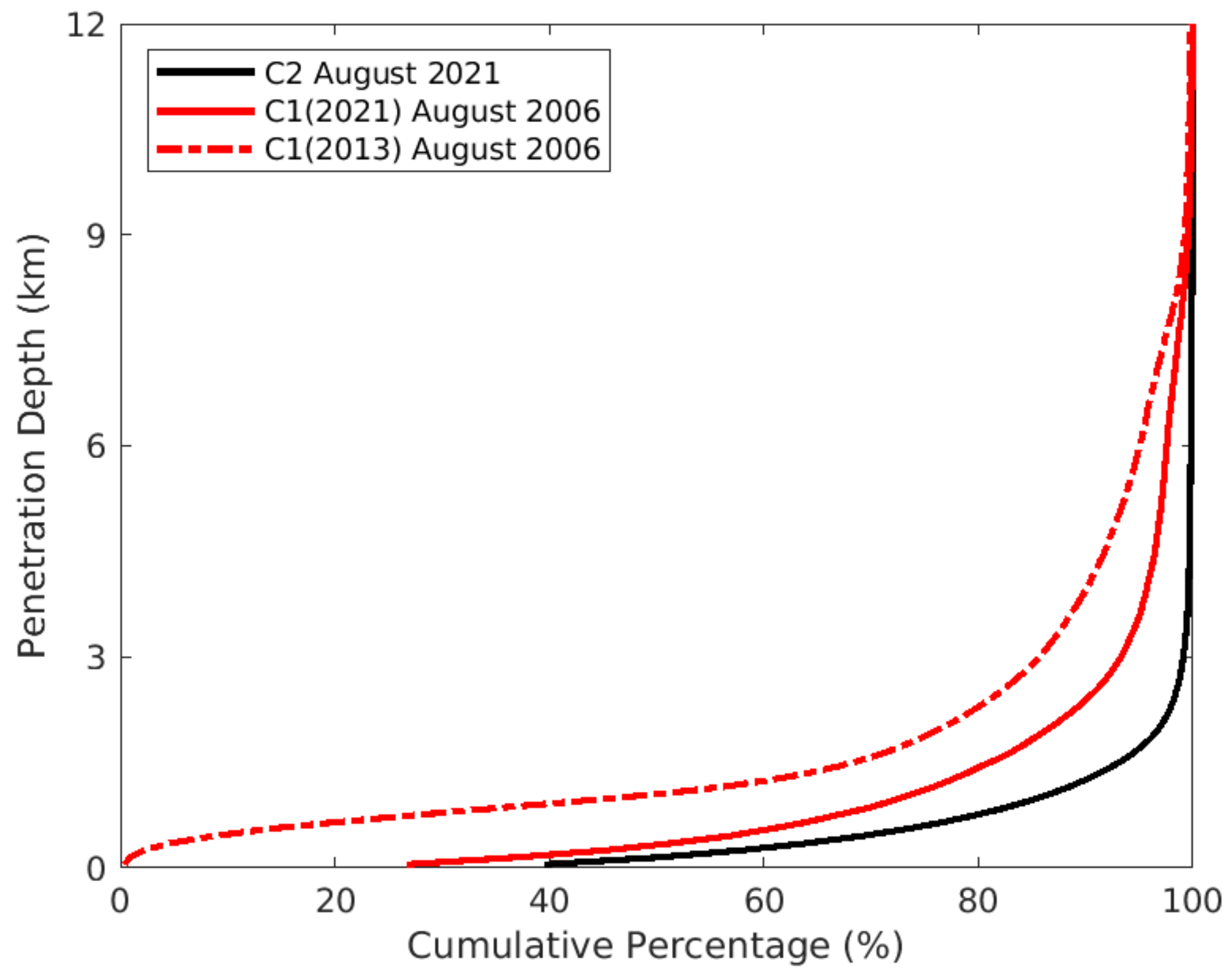
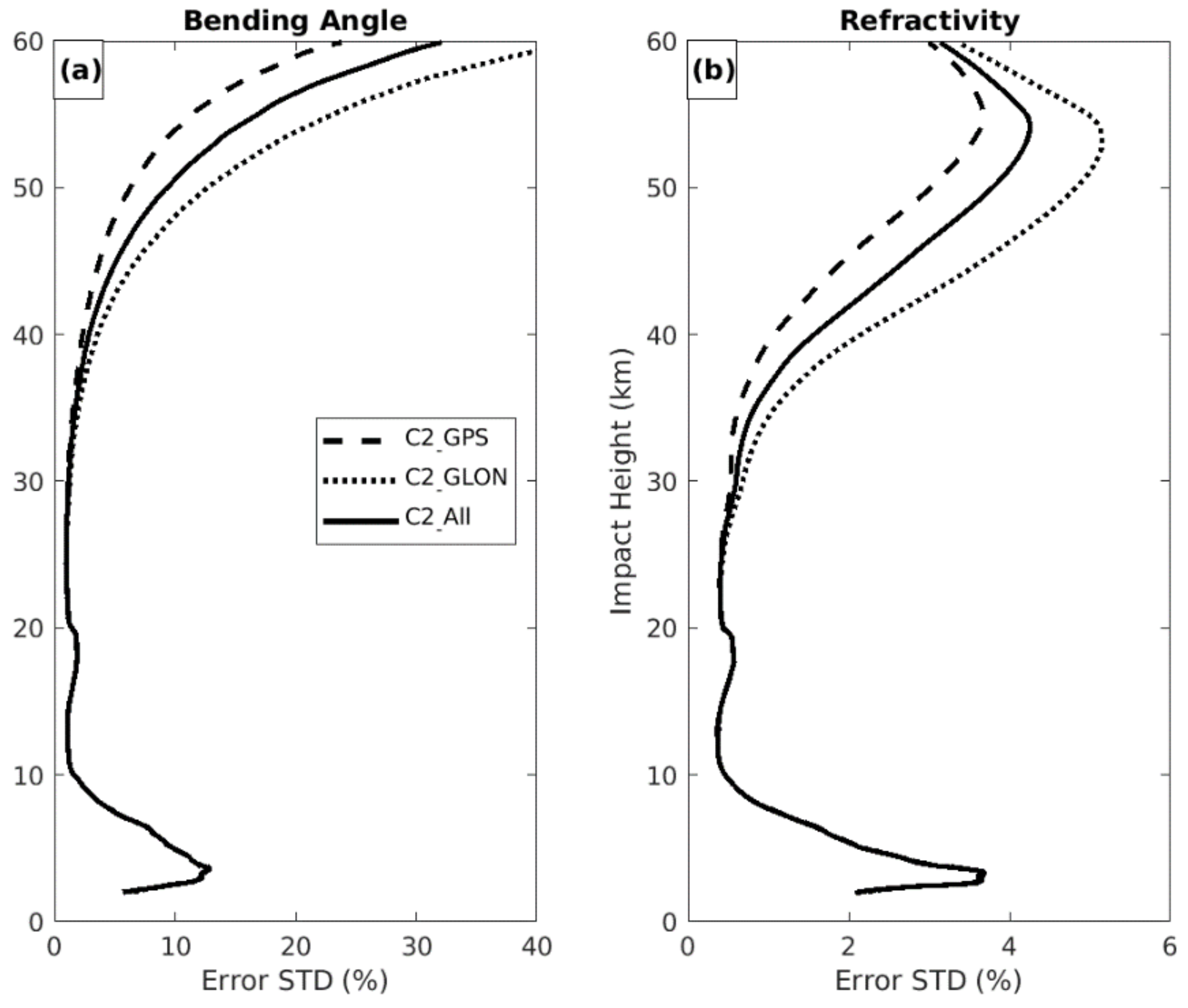
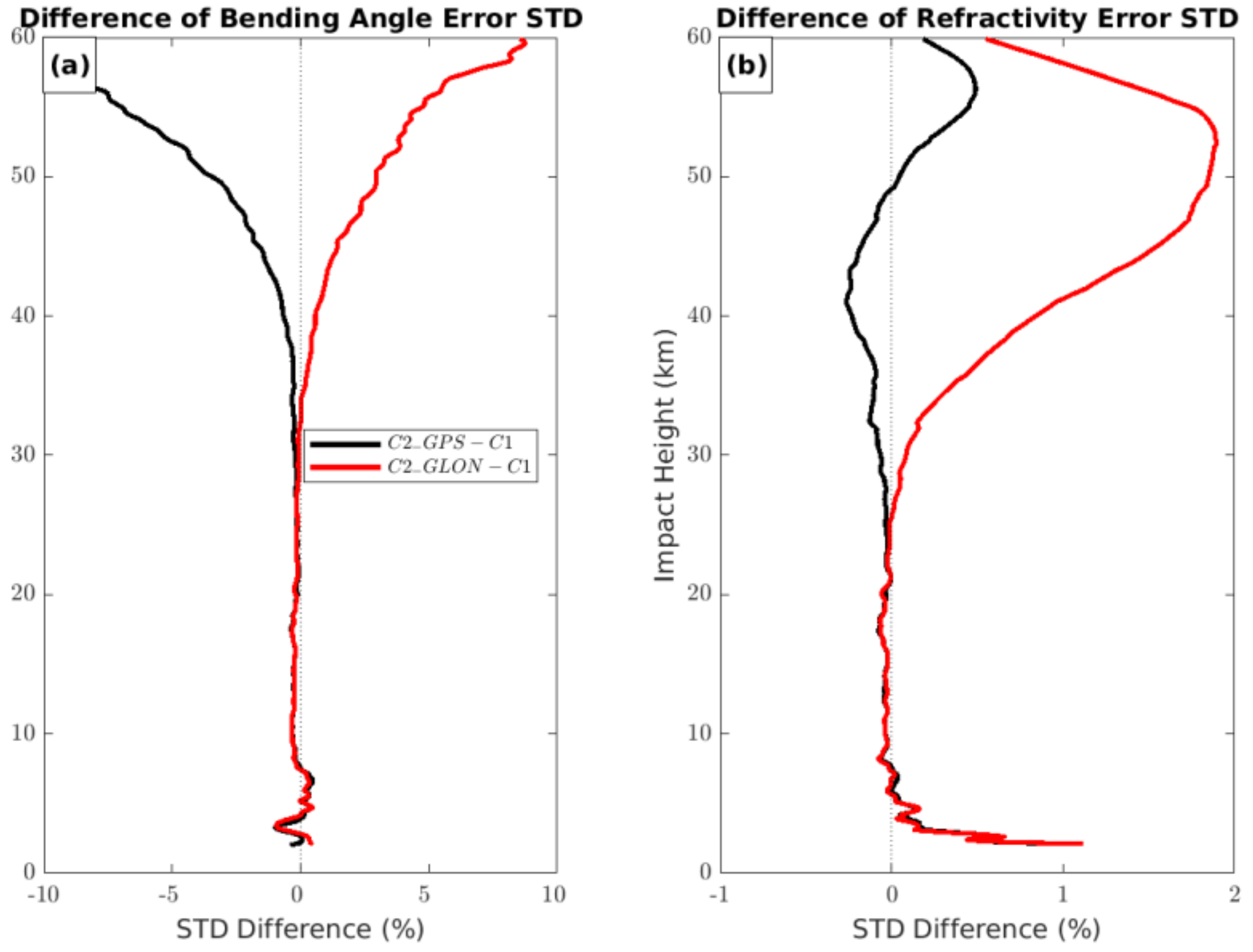

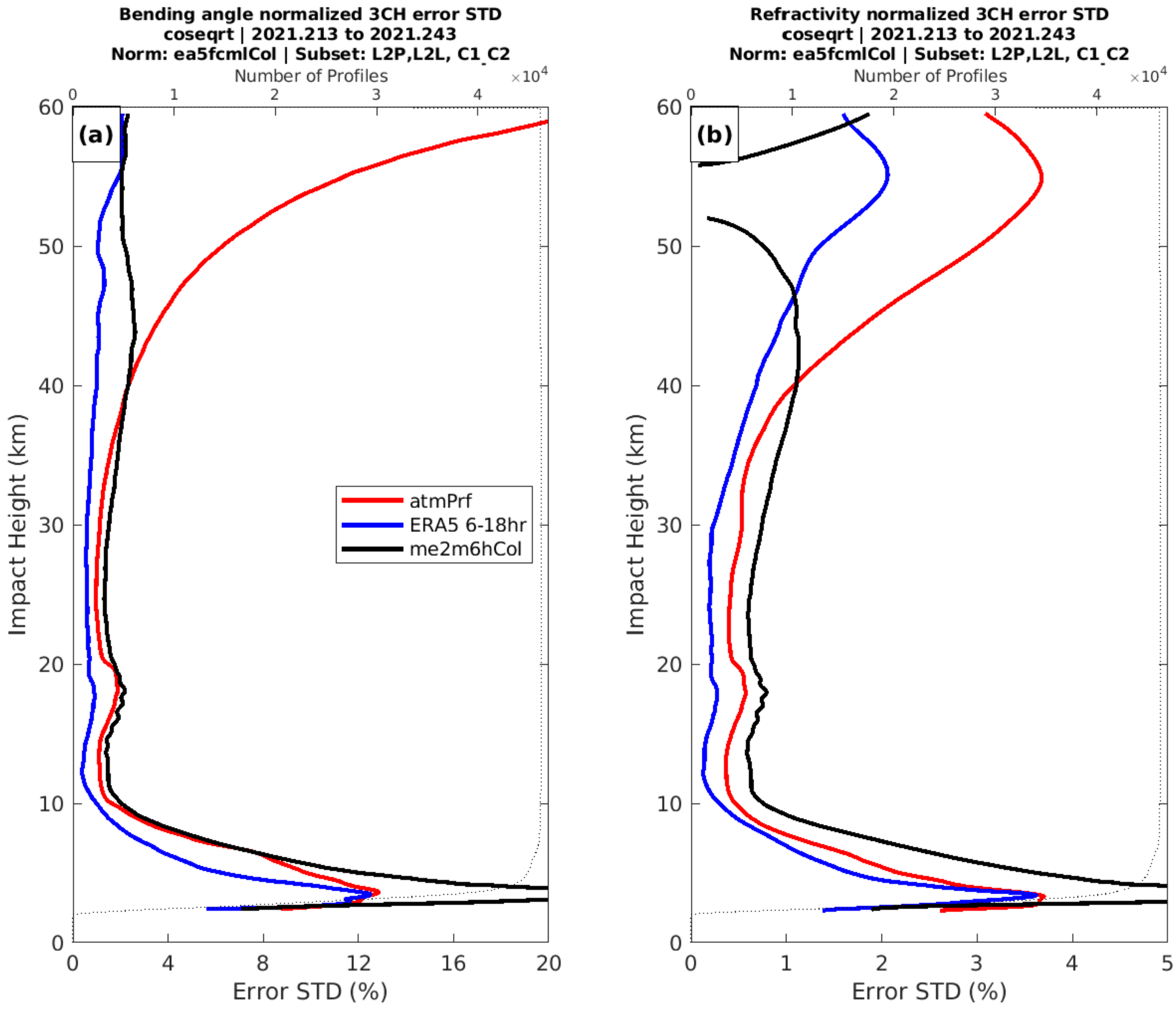
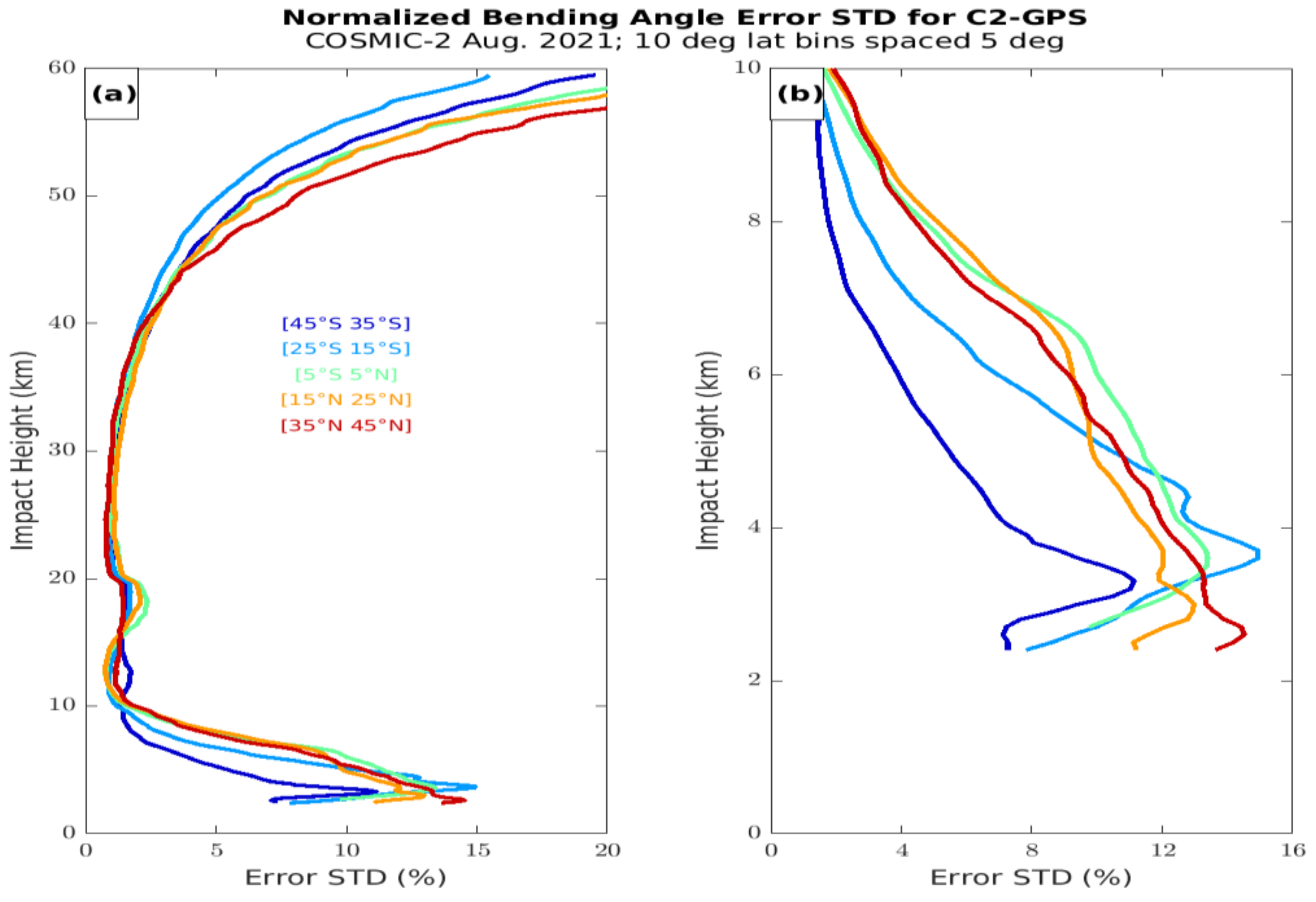

| Source | Predominant Altitudes | Comments |
|---|---|---|
| Orbit, receiver thermal noise, transmitter and receiver clock errors | Upper levels, above 30 km | Decrease exponentially with decreasing altitude. |
| Satellite multipath | Upper levels, above 30 km | Interference from signals scattered off solar panels and other objects on the satellite. Probably small. |
| Ionospheric residuals: remaining errors after correction due to ionospheric disturbances and scintillations | Upper levels, above 30 km. F2 scintillation can affect profiles at all levels. | Dominant source of uncertainty above 30 km. Effect varies with solar and local diurnal cycles and latitude. Primarily random errors, although there are small systematic higher-order residual errors that can be important for climate applications. Scintillations from sporadic-E are the biggest challenge. |
| Upper boundary condition: initialization of retrieval; optimal estimation of BA | Upper levels, above 30 km | Statistical optimization reduces uncertainty but may introduce bias errors. |
| L1 and L2 receiver tracking errors | Mainly in the troposphere, 0–10 km | Reduced using open-loop tracking. Deeper useful signal can be obtained with more power (antenna gain). |
| Transformation of reference frame to local center of Earth’s curvature | Lower levels, below ~20 km | Correction for Earth’s oblateness. Residual error after correction is mostly random but with vertical correlations. |
| Horizontal variations in refractivity (function of temperature and/or water vapor) producing a lack of spherical symmetry | UTLS and troposphere, especially the lower troposphere | Representativeness error when RO observations are interpreted as in situ measurements. |
| Geometric or wave optics retrieval | All levels | Both assume spherical symmetry. Vertical resolution of GO lower than WO, so the vertical footprint varies. Vertical filtering can reduce this. |
| Transition from geometric optics (GO) to wave optics (WO) | Tropopause region, 10–20 km. | Transition methods vary. EUMETSAT has no transition and uses WO at all levels. |
| Superrefraction (SR) or ducting in atmosphere | Lower troposphere, especially at the ABL top | Can calculate a BA profile in SR, but a unique refractivity profile is indeterminant from BA (underdetermined problem). Creates significant negative bias in N and BA. |
| Atmospheric multipath | Moist lower troposphere | Results in tracking errors. Multipath disentanglement assumes spherical symmetry. |
| Surface reflections | Lower troposphere | With assumption of spherical symmetry, direct and reflected rays can be separated by wave optics multipath disentanglement. Since reflected rays have smaller BA than direct rays, extraction of BA from a mixed spectrum may result in additional negative BA bias. |
| Other data sets (models and observations other than RO) | Differences introduced when data sets other than RO observations are used to compare with RO. | |
| Horizontal variability or gradients in refractivity | UTLS and troposphere, especially the lower troposphere | Creates horizontal representativeness (footprint) differences and collocation errors, as well as errors in the forward model. |
| Vertical variability, especially inversions | UTLS and lower troposphere, especially near the ABL top | Creates vertical representativeness (footprint) differences and collocation errors. |
| Temporal variability | All levels | Minor, through collocation errors. |
| Forward modeling errors | UTLS and lower troposphere, especially near the ABL top | Part of representativeness error. Temperature, pressure, and water vapor must be converted to RO bending angles using forward models. Use of two- or three-dimensional forward modelling can reduce representativeness errors resulting from a lack of spherical symmetry. |
| Error correlations of data set with RO observations | All levels | Example is a model analysis or forecast that assimilates RO observations. Accuracy of error estimates is decreased with error correlations among the comparative DS values. |
| Quality control | All levels | Will change estimated error statistics; more stringent QC produces smaller estimated error statistics but reduces the number of observations in a sample. |
Publisher’s Note: MDPI stays neutral with regard to jurisdictional claims in published maps and institutional affiliations. |
© 2022 by the authors. Licensee MDPI, Basel, Switzerland. This article is an open access article distributed under the terms and conditions of the Creative Commons Attribution (CC BY) license (https://creativecommons.org/licenses/by/4.0/).
Share and Cite
Anthes, R.; Sjoberg, J.; Feng, X.; Syndergaard, S. Comparison of COSMIC and COSMIC-2 Radio Occultation Refractivity and Bending Angle Uncertainties in August 2006 and 2021. Atmosphere 2022, 13, 790. https://doi.org/10.3390/atmos13050790
Anthes R, Sjoberg J, Feng X, Syndergaard S. Comparison of COSMIC and COSMIC-2 Radio Occultation Refractivity and Bending Angle Uncertainties in August 2006 and 2021. Atmosphere. 2022; 13(5):790. https://doi.org/10.3390/atmos13050790
Chicago/Turabian StyleAnthes, Richard, Jeremiah Sjoberg, Xuelei Feng, and Stig Syndergaard. 2022. "Comparison of COSMIC and COSMIC-2 Radio Occultation Refractivity and Bending Angle Uncertainties in August 2006 and 2021" Atmosphere 13, no. 5: 790. https://doi.org/10.3390/atmos13050790
APA StyleAnthes, R., Sjoberg, J., Feng, X., & Syndergaard, S. (2022). Comparison of COSMIC and COSMIC-2 Radio Occultation Refractivity and Bending Angle Uncertainties in August 2006 and 2021. Atmosphere, 13(5), 790. https://doi.org/10.3390/atmos13050790







